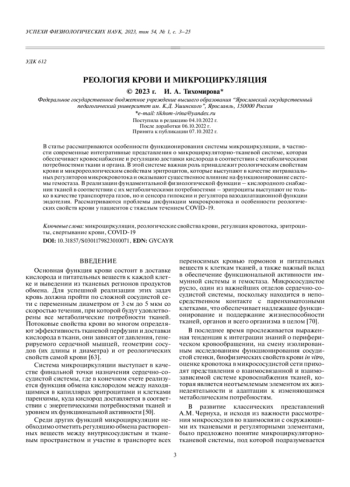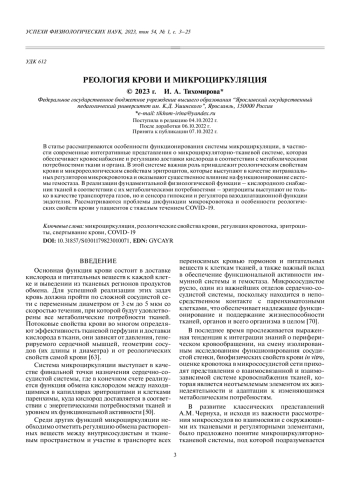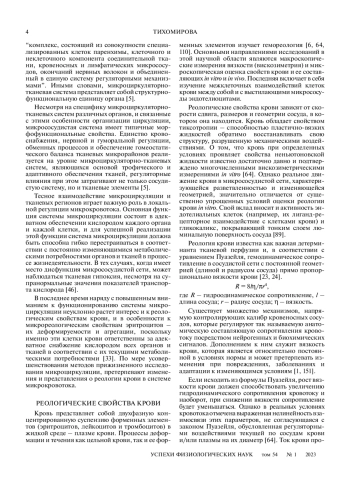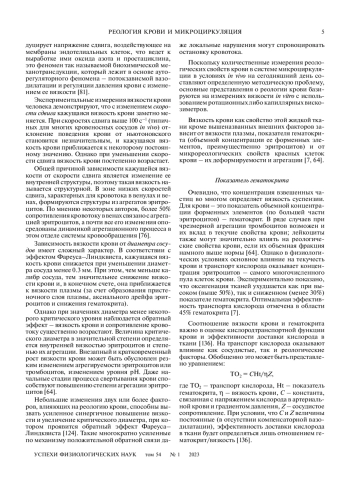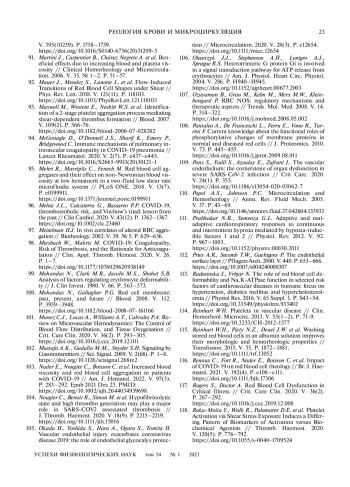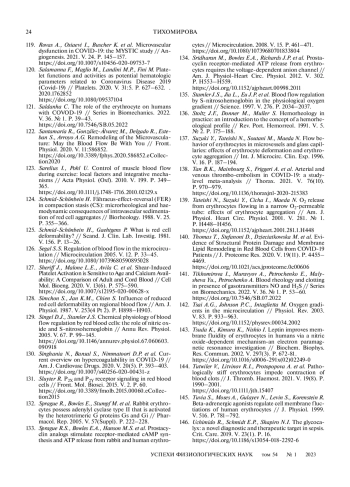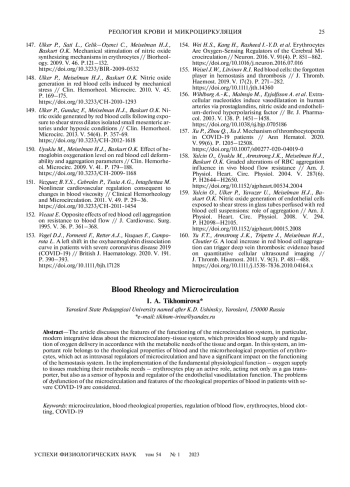В статье рассматриваются особенности функционирования системы микроциркуляции, в частности современные интегративные представления о микроциркуляторно-тканевой системе, которая обеспечивает кровоснабжение и регуляцию доставки кислорода в соответствии с метаболическими потребностями ткани и органа. В этой системе важная роль принадлежит реологическим свойствам крови и микрореологическим свойствам эритроцитов, которые выступают в качестве интравазальных регуляторов микрокровотока и оказывают существенное влияние на функционирование системы гемостаза. В реализации фундаментальной физиологической функции – кислородного снабжения тканей в соответствии с их метаболическими потребностями – эритроциты выступают не только в качестве транспортера газов, но и сенсора гипоксии и регулятора вазодилатационной функции эндотелия. Рассматриваются проблемы дисфункции микрокровотока и особенности реологических свойств крови у пациентов с тяжелым течением COVID-19.
Идентификаторы и классификаторы
- SCI
- Биология
Потоковые свойства крови во многом определяют эффективность тканевой перфузии и доставки кислорода в ткани, они зависят от давления, генерируемого сердечной мышцей, геометрии сосудов (их длины и диаметра) и от реологических свойств самой крови [63].
Список литературы
1. Галенок В.А., Гостинская Е.В., Диккер В.Е. Гемореология при нарушениях углеводного обмена. Новосибирск. Наука, 1987. 257 с.
2. Зинчук В.В., Максимович Н.А., Борисюк М.В. Функциональная система транспорта кислорода: фундаментальные и клинические аспекты / под ред. Зинчука В.В. Гродно, 2003. 236 с.
3. Зинчук В.В., Муравьев А.В., Билецкая Е.С. и соавт Влияние газотрансмиттеров и озона на микрореологию эритроцитов и кислородтранспортную функцию крови // Тромбоз, гемостаз и реология. 2022. № 2. С. 73–83. EDN: CHMRTO
4. Ильина Я.Ю., Фот Е.В., Кузьков В.В., Киров М.Ю. Сепсис-индуцированное повреждение эндотелиального гликокаликса (обзор литературы) // Вестник интенсивной терапии имени А.И. Салтанова. 2019. № 2. С. 32-39. DOI: 10.21320/1818-474X-2019-2-32-39 EDN: ZEURRJ
5. Крупаткин А.И., Сидоров В.В. Функциональная диагностика микроциркуляторно-тканевых систем: колебания, информация, нелинейность. М.: Книжный дом “ЛИБРОКОМ”, 2013. 496 с.
6. Левтов В.А., Регирер С.А., Шадрина Н.Х. Реология крови. М.: Медицина, 1982. 272 с.
7. Муравьев А.В., Чепоров С.В. Гемореология (экспериментальные и клинические аспекты реологии крови) / Ярославль: Изд-во ЯГПУ, 2009. 178 с. EDN: RGJGUV
8. Муравьев А.В., Михайлов П.В., Зинчук В.В., Тихомирова И.А., Остроумов Р.С. Гемореологические параметры у лиц с разным уровнем обеспечения организма кислородом: влияние оксида азота и сульфида водорода на микрореологические характеристики эритроцитов // Тромбоз, гемостаз и реология. 2021. № 4. С. 22–29. DOI: 10.25555/THR.2021.4.0993 EDN: IRBJIU
9. Муравьев А.В., Тихомирова И.А., Булаева С.В., Петроченко Е.П., Малышева Ю.В. Влияние газотрансмиттера монооксида углерода на микрореологию и эластичность мембран эритроцитов // Биологические мембраны. 2021. Т. 38. № 3. С. 217–224. DOI: 10.31857/S0233475521030063 EDN: CVTAIH
10. Петрищев Н.Н., Халепо О.В., Вавиленкова Ю.А., Власов Т.Д. COVID-19 и сосудистые нарушения (обзор литературы). Регионарное кровообращение и микроциркуляция. 2020. № 19(3). С. 90-98. DOI: 10.24884/1682-6655-2020-19-3-90-98 EDN: GWHLDR
11. Селезнев С.А., Назаренко Г.И., Зайцев В.С. Клинические аспекты микрогемоциркуляции. М.: Медицина, 1985. 179 с.
12. Тихомирова И.А., Рябов М.М. Сравнительный анализ показателей состояния системы гемостаза при тяжелом течении COVID-19 // Регионарное кровообращение и микроциркуляция. 2021. № 20(4). С. 87-94. DOI: 10.24884/1682-6655-2021-20-4-87-94 EDN: OYJPUD
13. Фирсов Н.Н., Джанашия П.Х. Введение в экспериментальную и клиническую гемореологию. М.: Изд-во ГОУ ВПО “РГМУ”, 2004. 280 с.
14. Фок М.В. Некоторые вопросы биохимической физики, важные для врачей. М.: Наука, 1999. 76 с.
15. Adderley S.P., Sridharan M., Bowles E.A. et al. Protein kinases A and C regulate receptor-mediated increases in cAMP in rabbit erythrocytes // Am. J. Physiol. Heart. Circ. Physiol. 2010. V. 298. P. H587–H593.
16. Al-Kuraishy H.M., Al-Gareeb A.I., Al-Hamash S.M. et al Changes in the Blood Viscosity in Patients With SARS-CoV-2 Infection // Front. Med. 2022. 9:876017. DOI: 10.3389/fmed.2022.876017 EDN: CURKAU
17. Azarov I., Huang K.T., Basu S. et al. Nitric oxide scavenging by red blood cells as a function of hematocrit and oxygenation // J. Biol. Chem. 2005. V. 280. P. 39 024–39 032.
18. Barrett T.J., Bilaloglu S., Cornwell M. et al. Platelets contribute to disease severity in COVID-19 // J. Thromb Haemost. 2021. V. 19. P. 3139–3153. DOI: 10.1111/jth.15534 EDN: GTEVGG
19. Barshtein G., Ben-Ami R., Yedgar S. Role of red blood cell flow behavior in hemodynamics and hemostasis // Expert Rev. Cardiovasc Ther. 2007. V. 5(4). P. 743-52. DOI: 10.1586/14779072.5.4.743
20. Barvitenko N.N., Adragna N.C., Weber R.E. Erythrocyte signal transduction pathways, their oxygenation dependence and functional significance // Cell Physiol. Biochem. 2005. V. 15. P. 1–18. DOI: 10.1159/000083634 EDN: LIYFNN
21. Barvitenko N.N., Aslam M., Filosa J. et al. Tissue Oxygen Demand in Regulation of the Behavior of the Cells in the Vasculature // Microcirculation. 2013. V. 20(6). P. 484–501. DOI: 10.1111/micc.12052 EDN: RFQVZP
22. Baskurt O.K., Meiselman H.J. Cellular determinants of low shear blood viscosity // Biorheology. 1997. V. 34(3). P. 235–247. EDN: AFTVMR
23. Baskurt O.K., Meiselman H.J. Blood rheology and hemodynamics // Semin. Thromb. Hemost. 2003. V. 29(5). P. 435-50. :. DOI: 10.1055/s-2003-44551
24. Baskurt O.K., Yalcin O., Meiselman H.J. Hemorheology and vascular control mechanisms // Clin. Hemorheol. Microcirc. 2004. V. 30. P. 169–178. EDN: NFCYRN
25. Baskurt O.K., Yalcin O., Ozdem S., Armstrong J.K., Meiselman H.J. Modulation of endothelial nitric oxide synthase expression by red blood cell aggregation // Am. J. Physiol. 2004. V. 286. P. H222–H229.
26. Baskurt O.K., Meiselman H.J. RBC aggregation: more important than RBC adhesion to endothelial cells as a determinant of in vivo blood flow in health and disease // Microcirculation. 2008. V. 15(7). P. 585–590. DOI: 10.1080/10739680802107447
27. Bateman R.M., Sharpe M.D., Ellis C.G. Bench-to bedside review: microvascular dysfunction in sepsis-hemodynamics, oxygen transport, and nitric oxide // Crit. Care. 2003. V. 7(5). P. 359–73. DOI: 10.1186/cc2353 EDN: EITXYE
28. Baumgartner H.R., Haudenschild C. Adhesion of platelets to subendothelium // Ann N.Y. Acad. Sci. 1972. V. 201. P. 22–36.
29. Bełtowski J. Leptin and the regulation of endothelial function in physiological and pathological conditions // J. Clin. Exp. Pharmacol. Physiol. 2012. V. 39(2). P. 168-78. x. DOI: 10.1111/j.1440-1681.2011.05623
30. Bergfeld G.R., Forrester T. Release of ATP from human erythrocytes in response to a brief period of hypoxia and hypercapnia // Cardiovasc. Res. 1992. V. 26. P. 40–47. EDN: IMZRST
31. Bogdanova A., Berenbrink M., Nikinmaa M. Oxygen-dependent ion transport in erythrocytes // Acta Physiol. (Oxf). 2009. V. 195. P. 305–319. x. DOI: 10.1111/j.1748-1716.2008.01934 EDN: MMWVGB
32. Broos K., Feys H.B., De Meyer S.F., Vanhoorelbeke K., Deckmyn H. Platelets at work in primary hemostasis // Blood Rev. 2011. V. 25(4). P. 155-67. DOI: 10.1016/j.blre.2011.03.002 EDN: OMRBUZ
33. Brun J.-F., Varlet-Marie E., Myzia J., Mercier J., Raynaud de Mauverger E. Extended physiological functions for erythrocyte deformability and aggregation beyond regulation of oxygen delivery? // Series in Biomechanics. 2022. V. 36. № 1. P. 7–20. DOI: 10.7546/SB.05.2022 EDN: IXDLZI
34. Brun J.-F., Varlet-Marie E., Myzi J., de Mauverger E.R., Pretorius E. Metabolic Influences Modulating Erythrocyte Deformability and Eryptosis // Metabolites. 2022. V. 12.4. DOI: 10.3390/metabo1201004.2021 EDN: GITTNO
35. Byrnes J.R., Wolberg A.S. Red blood cells in thrombosis // Blood. 2017. V. 130(16). P. 1795–1799. DOI: 10.1182/blood-2017-03-745349 EDN: YITZAJ
36. Cabel M., Meiselman H.J., Popel A.S., Johnson P.C. Contribution of red blood cell aggregation to venous vascular resistance in skeletal muscle // Am. J. Physiol. Heart Circ. Physiol. 1997. V. 272. № 41. P. H1020–1032.
37. Chammas J., Delaney D., Chabaytah N., Abdulkarim S., Schwertani A. COVID-19 and the cardiovascular system: insights into effects and treatments // Can. J. Physiol. Pharmacol. 2021. V. 1-9. P. 1119-1127. EDN: TBDHEK
38. Chen Y., Ju L.A. Biomechanical thrombosis: the dark side of force and dawn of mechano-medicine // Stroke & Vascular Neurology. 2020. 5:e000302. DOI: 10.1136/svn2019-000302 EDN: ZPXXIX
39. Chérif F., Laraba-Djebari F. Bioactive Molecules Derived from Snake Venoms with Therapeutic Potential for the Treatment of Thrombo Cardiovascular Disorders Associated with COVID 19 // The Protein J. 2021. 1–43. DOI: 10.1007/s10930-021-10019-4 EDN: OCAOGE
40. Chien S. Red cell deformability and its relevance to blood flow // Ann. Rev. Physiol. 1987. V. 49. P. 177–192.
41. Cokelet G.R., Goldsmith H.L. Decreased hydrodynamic resistance in the two-phase flow of blood through small vertical tubes at low flow rates // Circ. Res. 1991. V. 68. P. 1–17.
42. Connes P., Tripette J., Mukisi-Mukaza M. et al . Relationships between hemodynamic, hemorheological and metabolic responses during exercise // Biorheology. 2009. V. 46. P. 133–143.
43. Deonikar P., Kavdia M. Extracellular diffusion and permeability effects on NO-RBCs interactions using an experimental and theoretical model // Microvasc. Res. 2010. V. 79. P. 47–55. DOI: 10.1016/j.mvr.2009.10.002
44. Dietrich H.H., Ellsworth M.L., Sprague R.S., Dacey R.G. Jr. Red blood cell regulation of microvascular tone through adenosine triphosphate // Am. J. Physiol. Heart. Circ. Physiol. 2000. V. 278. P. H1294–H1298. DOI: 10.1152/ajpheart.2000.278.4.H1294
45. Duling B.R., Berne R.M. Longitudinal gradients in periarteriolar oxygen tension. A possible mechanism for the participation of oxygen in local regulation of blood flow // Circ. Res. 1970. V. 27. P. 669–678.
46. Ellis C.G., Jagger J., Sharpe M. The microcirculation as a functional system // Critical Care. 2005. V. 9(suppl 4). P. S3–S8. DOI: 10.1186/cc3751 EDN: KGIVCV
47. Ellsworth M.L., Pittman R.N. Arterioles supply oxygen to capillaries by diffusion as well as by convection // Am. J. Physiol. 1990. V. 258. P. H1240–H1243.
48. Ellsworth M.L., Ellis C.G., Goldman D. et al. Erythrocytes: oxygen sensors and modulators of vascular tone // Physiology. 2009. V. 24. P. 107–116. DOI: 10.1152/physiol.00038.2008
49. Estevez B., Du X. New concepts and mechanisms of platelet activation signaling // Physiology. 2017. V. 32. P. 16 277. DOI: 10.1152/physiol.00020.2016 EDN: YXAKIT
50. Fagrell B., Intaglietta M. Microcirculation: its significance in clinical and molecular medicine // J. Intern. Med. 1997. V. 241(5). P. 349-62. x. DOI: 10.1046/j.1365-2796.1997.125148000
51. Filosa J.A., Blanco V.M. Neurovascular coupling in the mammalian brain // Exp. Physiol. 2007. V. 92. P. 641–646. DOI: 10.1016/j.neuron.2017.07.030
52. Forconi S., Gori T. Endothelium and hemorheology // Clin. Hemorheol. Microcirc. 2013. V. 53(1–2). P. 3–10. DOI: 10.3233/CH-2012-1571
53. Foy B., Carlson J., Reinertsen E. et al. Association of Red Blood Cell Distribution Width With Mortality Risk in Hospitalized Adults With SARS-CoV-2 Infection // JAMA Netw. Open. 2020. V. 3(9):e2022058. DOI: 10.1001/jamanetworkopen.2020.22058 EDN: BSFMJT
54. Garcia-Herreros A., Yeh Y.-T., Peng Z., del Álamo J. Cyclic Mechanical Stresses Alter Erythrocyte Membrane Composition and Microstructure and Trigger Macrophage Phagocytosis // Adv. Sci. (Weinh). 2022. V. 9(20):e2201481. DOI: 10.1002/advs.202201481 EDN: EAISIY
55. Gersh K.C., Nagaswami C., Weisel J.W. Fibrin network structure and clot mechanical properties are altered by incorporation of erythrocytes // Thromb. Haemost. 2009. V. 102(6). P. 1169–1175. DOI: 10.1160/TH09-03-0199
56. Gillespie A.H., Doctor A. Red blood cell contribution to hemostasis // Front. Pediatr. 2021. V. 9:629824. DOI: 10.3389/fped.2021.629824 EDN: YUOWWF
57. Goldman D., Fraser G.M., Ellis C.G. et al Toward a multiscale description of microvascular flow regulation: O 2 -dependent release of ATP from human erythrocytes and the distribution of ATP in capillary networks // Frontiers in Physiology. 2012. V. 3. Article 246. DOI: 10.3389/fphys2012.00246
58. Gonzalez-Alonso J., Richardson R.S., Saltin B. Exercising skeletal muscle blood flow in humans responds to reduction in arterial oxyhaemoglobin, but not to altered free oxygen // J. Physiol. (Lond). 2001. V. 530. P. 331–341. l.x. DOI: 10.1111/j.1469-7793.2001.0331
59. Goto S., Ikeda Y., Saldivar E., Ruggeri Z.M. Distinct mechanisms of platelet aggregation as a consequence of different shearing flow conditions // J. Clin. Invest. 1998. V. 101. P. 479–486.
60. Guerci P., Ergin B., Uz Z. et al Glycocalyx Degradation Is Independent of Vascular Barrier Permeability Increase in Nontraumatic Hemorrhagic Shock in Rats // Anesth Analg. 2019. V. 129(2). P. 598–607. DOI: 10.1213/ANE.0000000000003918
61. Guven G., Hilty M.P., Ince C. Microcirculation: Physiology, Pathophysiology, and Clinical Application // Blood Purif. 2020. V. 49(1–2). P. 143–150. DOI: 10.1159/000503775
62. Gyawali P., Richards R.S., Hughes D.L., Tinley P. Erythrocyte aggregation and metabolic syndrome // Clin. Hemorheol. Microcirc. 2014. V. 57(1). P. 73–83. DOI: 10.3233/CH-131792 EDN: UTCDCX
63. Hamlin S., Benedik PS Basic concepts of hemorheology in microvascular hemodynamics // Crit. Care Nurs. Clin. N Am. 2014. V. 26. P. 337–344. DOI: 10.1016/j.ccell.2014.04.005 EDN: UPLBUH
64. Handbook of Hemorheology and Hemodynamics. Baskurt O.K., Hardeman M.R., Rampling M.W., Meiselman H.J.eds. IOS Press, 2007. 468 p.
65. Huisjes R., Bogdanova A., van Solinge W.W. et al. Squeezing for Life – Properties of Red Blood Cell Deformability // Front. Physiol. 2018. V. 9. P. 656. DOI: 10.3389/fphys.2018.00656 EDN: VHSXZK
66. Iba T., Levy J.H., Levi M., Thachil J. Coagulopathy in COVID-19 // Thromb. Haemost. 2020. V. 18. P. 2103–2109. DOI: 10.1111/jth.14975 EDN: ECLIIR
67. Ilich A., Sparkenbaugh E.M., Wolberg A.S., Key N.S., Pawlinski R. Pathologically stiff erythrocytes impede contraction of blood clots: comment // J. Thromb. Haemost. 2021. V. 19(11). P. 2893–2894. DOI: 10.1111/jth.15512 EDN: EFOSSO
68. Ince C., Mayeux P.R., Nguyen T. et al. The Endothelium in Sepsis // Shock. 2016. V. 45(3). P.259-70. DOI: 10.1097/SHK.0000000000000473
69. Jackson S.P. The growing complexity of platelet aggregation // Blood. 2007. V. 09(12). P. 5087-95. DOI: 10.1182/blood-2006-12-027698
70. Jacob M., Chappell D., Becker B.F. Regulation of blood flow and volume exchange across the microcirculation // Crit. Care. 2016. V. 20(1). P. 319. DOI: 10.1186/s13054-016-1485-0 EDN: ZOCCOU
71. Jacob M., Bruegger D., Rehm M. et al. The endothelial glycocalyx affords compatibility of Starling’s principle and high cardiac interstitial albumin levels // Cardiovascular Research. 2007. V. 73. P. 575–586. DOI: 10.1016/j.cardiores.2006.11.021 EDN: IMXAVF
72. Jagger J.E., Bateman R.M., Ellsworth M.L., Ellis C.G. Role of erythrocyte in regulating local O 2 delivery mediated by hemoglobin oxygenation // Am. J. Physiol. Heart Circ. Physiol. 2001. V. 280. P. H2833–H2839. DOI: 10.1152/ajpheart.2001.280.6.H2833
73. Jensen FB The dual roles of red blood cells in tissue oxygen delivery: oxygen carriers and regulators of local blood flow // J. Exp. Biol. 2009. V. 212. P. 3387–3393. DOI: 10.1242/jeb.023697
74. Jensen F.B., Rohde S. Comparative analysis of nitrite uptake and hemoglobin-nitrite reactions in erythrocytes: sorting out uptake mechanisms and oxygenation dependencies // Am. J. Physiol. Regulatory Integrative Comp Physiol. 2010. V. 298. P. R972–R982. DOI: 10.1152/ajpregu.00813.2009
75. Jia L., Bonaventura C., Bonaventura J., Stamler J.S. S-nitrosohaemoglobin: a dynamic activity of blood involved in vascular control // Nature. 1996. V. 380. P. 221–226.
76. Johnson P.C. The importance of red blood cell aggregation in vivo – the “pro” view // Biorheology. 1995. V. 32. № 2–3. P. 105–106.
77. Joob B., Wiwanitkit V. Blood viscosity of COVID-19 patient: a preliminary report // Am. J. Blood Res. 2021. V. 11(1). P. 93–95.
78. Kim S., Popel A.S., Intaglietta M., Johnson P.C. Effect of erythrocyte aggregation at normal human levels on functional capillary density in rat spinotrapezius muscle // Am. J. Physiol. Heart Circ. Physiol. 2006. V. 290. № 3. P. H941–947. DOI: 10.1152/ajpheart.00645.2005
79. Koller A., Kaley G. Endothelial regulation of wall shear stress and blood flow in skeletal muscle microcirculation // Am. J. Physiol. 1991. V. 260. P. H862–H868.
80. Koller A., Dornyei G., Kaley G. Flow-induced responses in skeletal muscle venules: modulation by nitric oxide and prostaglandins // Am. J. Physiol. Heart Circ. Physiol. 1998. V. 275. P. H831–H836.
81. Koller A., Toth P.J. Contribution of flow-dependent vasomotor mechanisms to the autoregulation of cerebral blood flow // Vasc. Res. 2012. V. 49(5). P. 375–89. DOI: 10.1159/000338747 EDN: YAMJYO
82. Kubánková M., Hohberger B., Hoffmanns J. et al. Physical phenotype of blood cells is altered in COVID-19 // Biophys. J. 2021.V. 120(14). P. 2838–2847. DOI: 10.1016/j.bpj.2021.05.025 EDN: VQLLMA
83. Labò N., Ohnuki H., Tosato G. Vasculopathy and coagulopathy associated with SARS-CoV-2 infection // Cells. 2020. V. 9(7). P. 1583. DOI: 10.3390/cells9071583 EDN: SYZYGU
84. Lang E., Lang F. Triggers, inhibitors, mechanisms, and significance of eryptosis: The suicidal erythrocyte death // BioMed Res. Int. 2015. V. 2015. P. 513518. DOI: 10.1155/2015/513518 EDN: UWICCP
85. Lanotte L., Mauer J., Mendez S. et al. Red cells’ dynamic morphologies govern blood shear thinning under microcirculatory flow conditions // Proc. Natl. Acad. Sci. USA. 2016. V. 113. P. 13289–13294. DOI: 10.1073/pnas.1608074113
86. Lee H., Na W., Lee B.-K., Lim C.-S., Shin S. Recent advances in microfluidic platelet function assays: Moving microfluidics into clinical applications // Clin. Hemorheol. Microcirc. 2019. V. 71(2). P. 249–266. DOI: 10.3233/CH-189416
87. Leung Y.M., Kwan C.Y. Dual vascular effects of leptin via endothelium: hypothesis and perspective // Chin. J. Physiol. 2008. V. 51(1). P. 1–6.
88. Li Z., Delaney M.K., O’Brien K.A., Du X. Signaling during platelet adhesion and activation // Arterioscler. Thromb. Vasc Biol. 2010. V. 30. P. 2341–2349. EDN: OMSPHX
89. Lipowsky H. Microvascular Rheology and Hemodynamics // Microcirculation. 2005. V. 12. P. 5–15. DOI: 10.1080/10739680590894966
90. Maier C.L., Truong A.D., Auld S.C. et al COVID-19-associated hyperviscosity: a link between inflammation and thrombophilia? // Lancet. 2020. V. 395(10239). P. 1758–1759. DOI: 10.1016/S0140-6736(20)31209-5 EDN: UADUTJ
91. Martini J., Carpentier B., Chávez Negrete A. et al. Beneficial effects due to increasing blood and plasma viscosity // Clinical Hemorheology and Microcirculation. 2006. V. 35. № 1–2. P. 51–57.
92. Mauer J., Mendez S., Lanotte L. et al. Flow-Induced Transitions of Red Blood Cell Shapes under Shear // Phys. Rev. Lett. 2018. V. 121(11). P. 118103. DOI: 10.1103/PhysRevLett.121.118103
93. Maxwell M., Westein E., Nesbitt W.S. et al. Identification of a 2-stage platelet aggregation process mediating shear-dependent thrombus formation // Blood. 2007. V. 109(2). P. 566-76. DOI: 10.1182/blood-2006-07-028282 EDN: RTSIEJ
94. McGonagle D., O’Donnell J.S., Sharif K., Emery P., Bridgewood C. Immune mechanisms of pulmonary intravascular coagulopathy in COVID-19 pneumonia // Lancet Rheumatol. 2020. V. 2(7). P. e437–e445. DOI: 10.1016/S2665-9913(20)30121-1 EDN: WHTBYH
95. Mehri R., Mavriplis C., Fenech M. Red blood cell aggregates and their effect on non-Newtonian blood viscosity at low hematocrit in a two-fluid low shear rate microfluidic system // PLoS ONE. 2018. V. 13(7). P. e0199911. DOI: 10.1371/journal.pone.0199911 EDN: VHLMNQ
96. Mehta J.L., Calcaterra G., Bassareo P.P. COVID-19, thromboembolic risk, and Virchow’s triad: lesson from the past // Clin Cardiol. 2020. V. 43(12). P. 1362–1367. DOI: 10.1002/clc.23460 EDN: VUWIXD
97. Meiselman H.J. In vivo correlates of altered RBC aggregation // Biorheology. 2002. V. 39. № 5. P. 629–636.
98. Miesbach W., Makris M. COVID-19: Coagulopathy, Risk of Thrombosis, and the Rationale for Anticoagulation // Clin. Appl. Thromb. Hemost. 2020. V. 26. P. 1–7. DOI: 10.1177/1076029620938149 EDN: BFKPEB
99. Mohandas N., Clark M.B., Jacobs M.S., Shohet S.B. Analysis of factors regulating erythrocyte deformability // J. Clin Invest. 1980. V. 66. P. 563–573.
100. Mohandas N., Gallagher P.G. Red cell membrane: past, present, and future // Blood. 2008. V. 112. P. 3939–3948. DOI: 10.1182/blood-2008-07-161166
101. Munoz C.J., Lucas A., Williams A.T., Cabrales P.A. Review on Microvascular Hemodynamics: The Control of Blood Flow Distribution, and Tissue Oxygenation // Crit. Care Clin. 2020. V. 36(2). P. 293–305. DOI: 10.1016/j.ccc.2019.12.011 EDN: VSOJYI
102. Mustafa A.K., Gadalla M.M., Snyder S.H. Signaling by Gasotransmitters // Sci. Signal. 2009. V. 2(68). P. 1–8. DOI: 10.1126/scisignal.268re2
103. Nader E., Nougier C., Boisson C. et al. Increased blood viscosity and red blood cell aggregation in patients with COVID-19 // Am. J. Hematol. 2022. V. 97(3). P. 283–292. Epub 2021 Dec 23. PMID: 10.1002/ajh.26440 34939698. DOI: 10.1002/ajh.2644034939698
104. Nougier C., Benoit R., Simon M. et al. Hypofibrinolytic state and high thrombin generation may play a major role in SARS-COV2 associated thrombosis // J. Thromb. Haemost. 2020. V.18(9). P. 2215-2219. DOI: 10.1111/jth.15016 EDN: YKRPER
105. Okada H., Yoshida S., Hara A., Ogura S., Tomita H. Vascular endothelial injury exacerbates coronavirus disease 2019: the role of endothelial glycocalyx protection // Microcirculation. 2020. V. 28(3). P. e12654. DOI: 10.1111/micc.12654 EDN: OVTLWJ
106. Olearczyk J.J., Stephenson A.H., Lonigro A.J., Sprague R.S. Heterotrimeric G protein Gi is involved in a signal transduction pathway for ATP release from erythrocytes // Am. J. Physiol. Heart Circ. Physiol. 2004. V. 286. P. H940–H945. DOI: 10.1152/ajpheart.00677.2003
107. Ozuyaman B., Grau M., Kelm M., Merx M.W., Kleinbongard P. RBC NOS: regulatory mechanisms and therapeutic aspects // Trends. Mol. Med. 2008. V. 14. P. 314–322. DOI: 10.1016/j.molmed.2008.05.002 EDN: MMYGZP
108. Pantaleo A., De Franceschi L., Ferru E., Vono R., Turrini F. Current knowledge about the functional roles of phosphorylative changes of membrane proteins in normal and diseased red cells // J. Proteomics. 2010. V. 73. P. 445–455. DOI: 10.1016/j.jprot.2009.08.011 EDN: NAGFCX
109. Pons S., Fodil S., Azoulay E., Zafrani L. The vascular endothelium: the cornerstone of organ dysfunction in severe SARS-CoV-2 infection // Crit Care. 2020. V. 24(1). P. 353. DOI: 10.1186/s13054-020-03062-7 EDN: AZEYEF
110. Popel A.S., Johnson P.C. Microcirculation and Hemorheology // Annu. Rev. Fluid Mech. 2005. V. 37. P. 43–69. DOI: 10.1146/annurev.fluid.37.042604.133933 EDN: MCSKXJ
111. Prabhakar N.R., Semenza G.L. Adaptive and maladaptive cardiorespiratory responses to continuous and intermittent hypoxia mediated by hypoxia-inducible factors 1 and 2 // Physiol. Rev. 2012. V. 92. P. 967–1003. DOI: 10.1152/physrev.00030.2011
112. Pries A.R., Secomb T.W., Gaehtgens P. The endothelial surface layer // Pflugers Arch. 2000. V. 440. P. 653–666. DOI: 10.1007/s004240000307 EDN: AVOYJV
113. Radosinska J., Vrbjar N. The role of red blood cell deformability and Na,K-ATPase function in selected risk factors of cardiovascular diseases in humans: focus on hypertension, diabetes mellitus and hypercholesterolemia // Physiol Res. 2016. V. 65 Suppl. 1. P. S43–54. DOI: 10.33549/physiolres.933402 EDN: YELCRS
114. Reinhart WH. Platelets in vascular disease // Clin. Hemorheol. Microcirc. 2013. V. 53(1–2). P. 71-9. DOI: 10.3233/CH-2012-1577
115. Reinhart W.H., Piety N.Z., Deuel J.W. et al. Washing stored red blood cells in an albumin solution improves their morphologic and hemorheologic properties // Transfusion. 2015. V. 55. P. 1872–1881. DOI: 10.1111/trf.13052
116. Renoux C., Fort R., Nader E., Boisson C. et al. Impact of COVID-19 on red blood cell rheology // Br. J. Haematol. 2021. V. 192(4). P. e108–e111. DOI: 10.1111/bjh.17306 EDN: XJHSRM
117. Rogers S., Doctor A. Red Blood Cell Dysfunction in Critical Illness // Crit. Care Clin. 2020. V. 36(2). P. 267–292. DOI: 10.1016/j.ccc.2019.12.008 EDN: CDRTJY
118. Roka-Moiia Y., Walk R., Palomares D.E. et al. Platelet Activation via Shear Stress Exposure Induces a Differing Pattern of Biomarkers of Activation versus Biochemical Agonists // Thromb. Haemost. 2020. V. 120(5). P. 776–792. DOI: 10.1055/s-0040-1709524 EDN: WZSDER
119. Rovas A., Osiaevi I., Buscher K. et al. Microvascular dysfunction in COVID-19: the MYSTIC study // Angiogenesis. 2021. V. 24. P. 145–157. DOI: 10.1007/s10456-020-09753-7 EDN: ZCVRXE
120. Salamanna F., Maglio M., Landini M.P., Fini M. Platelet functions and activities as potential hematologic parameters related to Coronavirus Disease 2019 (Covid-19) // Platelets. 2020. V. 31:5. P. 627-632.. 2020.1762852. DOI: 10.1080/09537104
121. Saldanha C. The role of the erythrocyte on humans with COVOD-19 // Series in Biomechanics. 2022. V. 36. № 1. P. 39–43. DOI: 10.7546/SB.05.2022 EDN: YNZBMP
122. Santamaría R., González-Álvarez M., Delgado R., Esteban S., Arroyo A.G. Remodeling of the Microvasculature: May the Blood Flow Be With You // Front. Physiol. 2020. V. 11:586852. DOI: 10.3389/fphys.2020.586852.eCollection2020 EDN: EJMGHR
123. Sarelius I., Pohl U. Control of muscle blood flow during exercise: local factors and integrative mechanisms // Acta Physiol. (Oxf). 2010. V. 199. P. 349–365. x. DOI: 10.1111/j.1748-1716.2010.02129 EDN: NZPSUD
124. Schmid-Schönbein H. Fåhraeus-effect-reversal (FER) in compaction stasis (CS): microrheological and haemodynamic consequences of intravascular sedimentation of red cell aggregates // Biorheology. 1988. V. 25. P. 355–366.
125. Schmid-Schönbein H., Gaehtgens P. What is red cell deformability? // Scand. J. Clin. Lab. Investig. 1981. V. 156. P. 13–26.
126. Segal S.S. Regulation of blood flow in the microcirculation // Microcirculation 2005. V. 12. P. 33–45. DOI: 10.1080/10739680590895028
127. Sheriff J., Malone L.E., Avila C. et al. Shear-Induced Platelet Activation is Sensitive to Age and Calcium Availability: A Comparison of Adult and Cord Blood // Cell Mol. Bioeng. 2020. V. 13(6). P. 575–590. -x. DOI: 10.1007/s12195-020-00628 EDN: EUPDLO
128. Simchon S., Jan K.M., Chien S. Influence of reduced red cell deformability on regional blood flow // Am. J. Physiol. 1987. V. 253(4 Pt 2). P. H898–H903.
129. Singel D.J., Stamler J.S. Chemical physiology of blood flow regulation by red blood cells: the role of nitric oxide and S-nitrosohemoglobin // Annu Rev. Physiol. 2005. V. 67. P. 99–145. 090918. DOI: 10.1146/annurev.physiol.67.060603 EDN: LUVCLJ
130. Singhania N., Bansal S., Nimmatoori D.P. et al. Current overview on hypercoagulability in COVID-19 // Am. J. Cardiovasc Drugs. 2020. V. 20(5). P. 393–403. -z. DOI: 10.1007/s40256-020-00431
131. Sluyter R. P 2X and P 2Y receptor signaling in red blood cells // Front. Mol. Biosci. 2015. V. 2. P. 60. DOI: 10.3389/fmolb.2015.00060.eCollection2015
132. Sprague R., Bowles E., Stumpf M. et al. Rabbit erythrocytes possess adenylyl cyclase type II that is activated by the heterotrimeric G proteins Gs and Gi // Pharmacol. Rep. 2005. V. 57(Suppl). P. 222–228.
133. Sprague R.S., Bowles E.A., Hanson M.S. et al Prostacyclin analogs stimulate receptor-mediated cAMP synthesis and ATP release from rabbit and human erythrocytes // Microcirculation. 2008. V. 15. P. 461–471. DOI: 10.1080/10739680701833804
134. Sridharan M., Bowles E.A., Richards J.P. et al. Prostacyclin receptor-mediated ATP release from erythrocytes requires the voltage-dependent anion channel // Am. J. Physiol-Heart Circ. Physiol. 2012. V. 302. P. H553–H559. DOI: 10.1152/ajpheart.00998.2011 EDN: PQFFBH
135. Stamler J.S., Jia L., Eu J.P. et al. Blood flow regulation by S-nitrosohemoglobin in the physiological oxygen gradient // Science. 1997. V. 276. P. 2034–2037. EDN: EKFXWX
136. Stoltz J.F., Donner M., Muller S. Hemorheology in practice: an introduction to the concept of a hemorheological profile // Rev. Port. Hemorreol. 1991. V. 5. № 2. P. 175–188.
137. Suzuki Y., Tateishi N., Soutani M., Maeda N. Flow behavior of erythrocytes in microvessels and glass capillaries: effects of erythrocyte deformation and erythrocyte aggregation // Int. J. Microcirc. Clin. Exp. 1996. V. 16. P. 187–194.
138. Tan B.K., Mainbourg S., Friggeri A. et al Arterial and venous thrombo-embolism in COVID-19: a study-level meta-analysis // Thorax. 2021. V. 76(10). P. 970–979. DOI: 10.1136/thoraxjnl-2020-215383 EDN: OMSNWR
139. Tateishi N., Suzuki Y., Cicha I., Maeda N. O 2 release from erythrocytes flowing in a narrow O 2 -permeable tube: effects of erythrocyte aggregation // Am. J. Physiol. Heart Circ. Physiol. 2001. V. 281. № 1. P. H448–H456. DOI: 10.1152/ajpheart.2001.281.1.H448
140. Thomas T., Stefanoni D., Dzieciatkowska M. et al. Evidence of Structural Protein Damage and Membrane Lipid Remodeling in Red Blood Cells from COVID-19 Patients // J. Proteome Res. 2020. V. 19(11). P. 4455–4469. DOI: 10.1021/acs.jproteome.0c00606 EDN: IUMGAJ
141. Tikhomirova I., Muravyov A., Petrochenko E., Malysheva Yu., Petrochenko A. Blood rheology and clotting in presence of gasotransmitters NO and H 2 S // Series on Biomechanics. 2022. V. 36. № 1. P. 53–60. DOI: 10.7546/SB.07.2022 EDN: LULVPJ
142. Tsai A.G., Johnson P.C., Intaglietta M. Oxygen gradients in the microcirculation // Physiol. Rev. 2003. V. 83. P. 933–963. DOI: 10.1152/physrev.00034.2002 EDN: LVFZMP
143. Tsuda K., Kimura K., Nishio I. Leptin improves membrane fluidity of erythrocytes in humans via a nitric oxide-dependent mechanism-an electron paramagnetic resonance investigation // Biochem. Biophys. Res. Commun. 2002. V. 297(3). P. 672-81. DOI: 10.1016/s0006-291x(02)02249-0 EDN: BCNWIX
144. Tutwiler V., Litvinov R.I., Protopopova A. et al. Pathologically stiff erythrocytes impede contraction of blood clots // J. Thromb. Haemost. 2021. V. 19(8). P. 1990–2001. DOI: 10.1111/jth.15407 EDN: HIQJXF
145. Tuvia S., Moses A., Gulayev N., Levin S., Korenstein R. Beta-adrenergic agonists regulate cell membrane fluctiations of human erythrocytes // J. Physiol. 1999. V. 516. P. 781–792. EDN: YBJPJZ
146. Uchimido R., Schmidt E.P., Shapiro N.I. The glycocalyx: a novel diagnostic and therapeutic target in sepsis. Crit. Care. 2019. V. 23(1). P. 16. DOI: 10.1186/s13054-018-2292-6 EDN: TBKQUW
147. Ulker P., Sati L., Celik–Ozenci C., Meiselman H.J., Baskurt O.K. Mechanical stimulation of nitric oxide synthesizing mechanisms in erythrocytes // Biorheology. 2009. V. 46. P.121–132. DOI: 10.3233/BIR-2009-0532 EDN: MZYZHL
148. Ulker P., Meiselman H.J., Baskurt O.K. Nitric oxide generation in red blood cells induced by mechanical stress // Clin. Hemorheol. Microcirc. 2010. V. 45. P. 169–175. DOI: 10.3233/CH-2010-1293 EDN: MZYZIZ
149. Ulker P., Gunduz F., Meiselman H.J., Baskurt O.K. Nitric oxide generated by red blood cells following exposure to shear stress dilates isolated small mesenteric arteries under hypoxic conditions // Clin. Hemorheol. Microcirc. 2013. V. 54(4). P. 357-69. DOI: 10.3233/CH-2012-1618 EDN: SQMXMX
150. Uyuklu M., Meiselman H.J., Baskurt O.K. Effect of hemoglobin oxygenation level on red blood cell deformability and aggregation parameters // Clin. Hemorheol. Microcirc. 2009. V. 41. P. 179–188. DOI: 10.3233/CH-2009-1168 EDN: MJQPHP
151. Vazquez B.Y.S., Cabrales P., Tsaia A.G., Intagliettaa M. Nonlinear cardiovascular regulation consequent to changes in blood viscosity // Clinical Hemorheology and Microcirculation. 2011. V. 49. P. 29–36. DOI: 10.3233/CH-2011-1454
152. Vicaut E. Opposite effects of red blood cell aggregation on resistance to blood flow // J. Cardiovasc. Surg. 1995. V. 36. P. 361–368.
153. Vogel D.J., Formenti F., Retter A.J., Vasques F., Camporota L. A left shift in the oxyhaemoglobin dissociation curve in patients with severe coronavirus disease 2019 (COVID-19) // British J. Haematology. 2020. V. 191. P. 390–393. DOI: 10.1111/bjh.17128 EDN: KPWCKI
154. Wei H.S., Kang H., Rasheed I.-Y.D. et al. Erythrocytes Are Oxygen-Sensing Regulators of the Cerebral Microcirculation // Neuron. 2016. V. 91(4). P. 851–862. DOI: 10.1016/j.neuron.2016.07.016 EDN: XUKKID
155. Weisel J.W., Litvinov R.I. Red blood cells: the forgotten player in hemostasis and thrombosis // J. Thromb. Haemost. 2019. V. 17(2). P. 271–282. DOI: 10.1111/jth.14360 EDN: UQFDEO
156. Wihlborg A.-K., Malmsjo M., Eyjolfsson A. et al. Extracellular nucleotides induce vasodilatation in human arteries via prostaglandins, nitric oxide and endothelium-derived hyperpolarising factor // Br. J. Pharmacol. 2003. V. 138. P. 1451–1458. DOI: 10.1038/sj.bjp.0705186
157. Xu P., Zhou Q., Xu J. Mechanism of thrombocytopenia in COVID-19 patients // Ann Hematol. 2020. V. 99(6). P. 1205–12508. DOI: 10.1007/s00277-020-04019-0 EDN: LRLVOS
158. Yalcin O., Uyuklu M., Armstrong J.K., Meiselman H.J., Baskurt O.K. Graded alterations of RBC aggregation influence in vivo blood flow resistance // Am. J. Physiol. Heart. Circ. Physiol. 2004. V. 287(6). P. H2644–H2650. DOI: 10.1152/ajpheart.00534.2004
159. Yalcin O., Ulker P., Yavuzer U., Meiselman H.J., Baskurt O.K. Nitric oxide generation of endothelial cells exposed to shear stress in glass tubes perfused with red blood cell suspensions: role of aggregation // Am. J. Physiol. Heart. Circ. Physiol. 2008. V. 294. P. H2098–H2105. DOI: 10.1152/ajpheart.00015.2008
160. Yu F.T., Armstrong J.K., Tripette J., Meiselman H.J., Cloutier G. A local increase in red blood cell aggregation can trigger deep vein thrombosis: evidence based on quantitative cellular ultrasound imaging // J. Thromb. Haemost. 2011. V. 9(3). P. 481–488. x. DOI: 10.1111/j.1538-7836.2010.04164
Выпуск
Другие статьи выпуска
Церамиды – биологически активные липиды с широким спектром биологических и патофизиологических эффектов, выполняющие в жировой ткани (ЖТ) роль вторичного мессенджера, регулирующего метаболический гомеостаз всего организма [83]. Известны 3 пути синтеза церамидов: de novo, сфингомиелиназный и рециркуляции/“спасения” [47]. В настоящем обзоре обобщены данные о физиологических и патофизиологических эффектах ферментов биосинтеза церамидов de novo.
Ангедония, и в частности социальная ангедония – важный психопатологический симптом, играющий ключевую роль в развитии депрессий и шизофрении. У здоровых людей уровень социальной ангедонии ассоциирован с изменением структуры, активации и функциональных связей различных участков префронтальной коры, височной и височно-теменной областей, а также базальных ядер. Для пациентов с шизофренией ключевые фМРТ-корреляты социальной ангедонии локализуются в височной доле. В отношении лиц с депрессией и другими психическими расстройствами полученные результаты недостаточны для обобщения. В отличие от физической ангедонии, социальная не демонстрирует специфичной ассоциации с объемом и активацией прилежащего ядра.
В обзоре обобщены современные сведения литературы о механизмах патогенеза тяжелого, индуцируемого стрессом заболевания – посттравматического стрессового расстройства (ПТСР). Охарактеризованы происходящие при ПТСР гормональные, биохимические, генетические и морфофункциональные изменения в периферических органах и в ЦНС. Выяснилось, что у большинства исследователей сформировалось мнение о ведущей роли хронического воспаления при ПТСР. Приведены данные изучения действия противовоспалительных средств, имеющих узкую биохимическую направленность. Обзор завершается представлением гипотезы о том, что патогенез ПТСР следует рассматривать как интегративный воспалительный процесс периферических и центральных систем. Терапевтическим средством в таком случае, вероятнее всего, должно быть полифункциональное лекарственное средство. Судя по результатам экспериментов авторов, вероятнее всего это должны быть препараты фармакологической группы гепаринов.
Хорошо известно, что витамины являются необходимыми микронутриентами для нормального функционирования всех систем организма и должны поступать в достаточном количестве с пищей. Роль витаминов, продуцирумых кишечной микробиотой, для здоровья хозяина практически не определена. В обзоре рассматриваются свойства восьми водорастворимых витаминов группы B, их комплексные эффекты на функционирование нервной системы. Уделяется внимание малоизученному вопросу – синтезу витаминов группы В кишечной микробиотой и ее роли в дефиците витаминов в организме. Предполагается, что взаимосвязанные факторы – “западная диета”, измененный состав (дисбиоз) кишечной микробиоты и дефицит витаминов группы В вовлечены в патогенез рассеянного склероза, тяжелого аутоиммунного демиелинизирующего заболевания, поражающего людей трудоспособного возраста. Приводятся имеющиеся исследования по оценке уровня витаминов группы B у пациентов с рассеянным склерозом и применению высоких доз этих витаминов для лечения прогрессирующих форм рассеянного склероза. Кроме того, высказывается идея о возможности использования пробиотических бактерий-продуцентов витаминов группы B в терапии рассеянного склероза.
Статистика статьи
Статистика просмотров за 2025 год.
Издательство
- Издательство
- ИЗДАТЕЛЬСТВО НАУКА
- Регион
- Россия, Москва
- Почтовый адрес
- 121099 г. Москва, Шубинский пер., 6, стр. 1
- Юр. адрес
- 121099 г. Москва, Шубинский пер., 6, стр. 1
- ФИО
- Николай Николаевич Федосеенков (Директор)
- E-mail адрес
- info@naukapublishers.ru
- Контактный телефон
- +7 (495) 2767735
